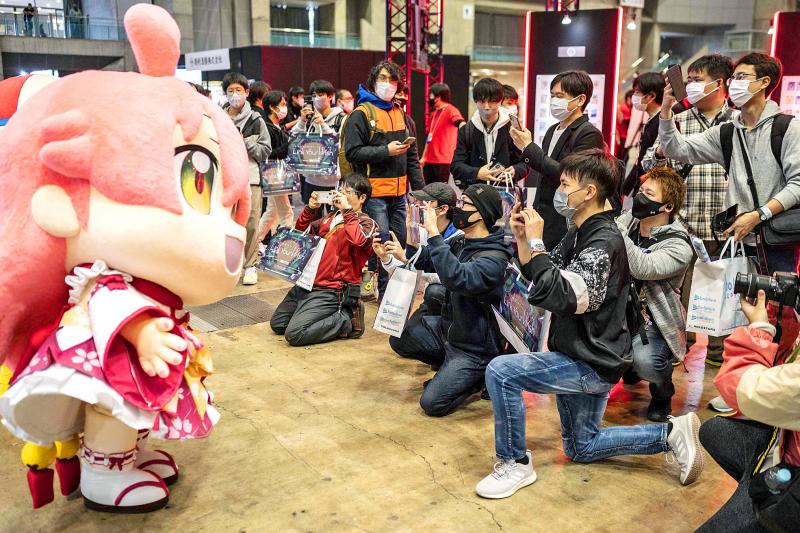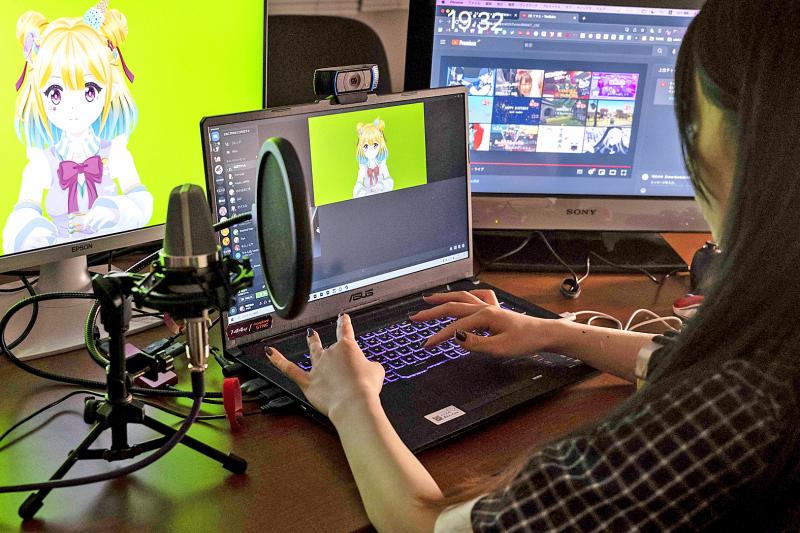Mayu Iizuka sheds her soft-spoken personality and starts cackling, screaming and waving wildly in a makeshift studio in Tokyo as her avatar appears on a livestream before hundreds of fans.
Virtual YouTubers such as Iizuka, who voices and animates a character called Yume Kotobuki, have transformed a niche Japanese subculture into a thriving industry where top accounts can rake in more than US$1 million a year.
The videos are designed to make fans feel they are interacting directly with their favorite animated idols — with viewers sometimes paying hundreds of US dollars to have a single comment highlighted on a livestream.

Photo: AFP
“When I’m playing video games on my channel and succeed at something, my fans congratulate me” and pay tips “as a way to show their support and appreciation,” Iizuka said.
The 26-year-old uses a laptop, Webcam and a motion sensor worn around her neck to appear on screen as Yume, whose facial expressions are controlled by a producer.
With her squeaky voice, short skirt and huge purple eyes, Iizuka’s avatar follows a popular model for “VTuber” characters, which often resemble the hyper-feminine heroines of Japanese anime.

Photo: AFP
Since emerging about five years ago, the VTuber world has grown quickly, with about 16,000 active streamers globally, data firm User Local said.
Fanbases are also growing on other platforms such as TikTok and gaming site Twitch.
Regional governments in Japan have used them for promotion, and The Batman stars Robert Pattinson and Zoe Kravitz even gave a recent interview to a top Japanese VTuber.

Photo: AFP
VTubers generate money in ways similar to traditional livestreamers, including through YouTube’s “Super Chat” system, where the more a fan shells out, the more attention is drawn to their comments.
The world’s nine top-earning YouTube accounts for “Super Chat” last year were all VTubers.
All nine are affiliated with one Tokyo-based talent agency, and each earned between US$700,000 and US$1.7 million from the cash gifts, data analysis Web site Playboard said.
Most fans spend only a few hundred yen per comment, but the most dedicated sometimes splurge ¥50,000 (US$383) to post impassioned missives to their virtual idols.
Kazuma Murakami, a 30-year-old auto parts inspector, has been known to spend ¥10,000 to get his comments highlighted in red and seen by his favorite VTuber.
“I really want her to notice I’m here again, visiting her channel,” Murakami said.
Another VTuber fan, who asked to be identified only by his first name, Kazumi, has adorned his tiny one-room apartment near Tokyo with posters, framed pictures and key rings featuring his favorite character, Mio Ookami.
The 30-year-old computer engineer spends time after work and on weekends immersing himself in Mio’s videos and crafting digital illustrations of the black-haired “wolf girl.”
“I dedicate five, or maybe 10 hours to thinking just about her,” he said. “She is like family to me.”
That devotion, and the willingness of fans to pay big money, is linked to the way other fan subcultures function in Japan, said Noriyuki Nagamatsu, a digital business specialist at advertising firm D.A. Consortium.
“Super Chat is essentially an extension of a longstanding culture where idol and anime fans try to support their oshi, or favorite, by splurging on their merchandise,” he said. “It’s also a way of winning attention from their beloved and feeling superior to fellow fans.”
VTubers usually keep the person behind the character — often referred to as their “soul” — out of the picture, and like many fans, Kazumi said his love is directed towards Mio the avatar, not whoever plays her.
However, the line between virtual and real can become blurred.
A Japanese court recently ruled in favor of a VTuber actor who said that online slander against her character amounted to an attack on her.
Virtual YouTubers can “transcend gender, age or physique ... but what’s important is that there’s a real person there who is speaking and reads the comments in real life,” said Kazuhito Ozawa, the plaintiff’s lawyer.
For Iizuka, a professional voice actress, making the rare decision to reveal her identity after four years of making videos as Yume was nerve-wracking.
“Part of me was afraid that fans of Yume, who has these big, shiny eyes and a perfect belly, might be disappointed to find out what the ‘real’ person inside looks like,” she said, adding that “so far the response from fans has been very kind.”
The more outspoken, vivacious personality of Yume’s virtual self is even gradually rubbing off on Iizuka, she said.
“I used to baulk at speaking publicly, but Yume is such an experienced livestreamer that my identity as her has been helping me speak more confidently,” she said.

Taiwan will prioritize the development of silicon photonics by taking advantage of its strength in the semiconductor industry to build another shield to protect the local economy, National Development Council (NDC) Minister Paul Liu (劉鏡清) said yesterday. Speaking at a meeting of the legislature’s Economics Committee, Liu said Taiwan already has the artificial intelligence (AI) industry as a shield, after the semiconductor industry, to safeguard the country, and is looking at new unique fields to build more economic shields. While Taiwan will further strengthen its existing shields, over the longer term, the country is determined to focus on such potential segments as

UNCERTAINTY: Innolux activated a stringent supply chain management mechanism, as it did during the COVID-19 pandemic, to ensure optimal inventory levels for customers Flat-panel display makers AUO Corp (友達) and Innolux Corp (群創) yesterday said that about 12 to 20 percent of their display business is at risk of potential US tariffs and that they would relocate production or shipment destinations to mitigate the levies’ effects. US tariffs would have a direct impact of US$200 million on AUO’s revenue, company chairman Paul Peng (彭雙浪) told reporters on the sidelines of the Touch Taiwan trade show in Taipei yesterday. That would make up about 12 percent of the company’s overall revenue. To cope with the tariff uncertainty, AUO plans to allocate its production to manufacturing facilities in

COLLABORATION: Given Taiwan’s key position in global supply chains, the US firm is discussing strategies with local partners and clients to deal with global uncertainties Advanced Micro Devices Inc (AMD) yesterday said it is meeting with local ecosystem partners, including Taiwan Semiconductor Manufacturing Co (TSMC, 台積電), to discuss strategies, including long-term manufacturing, to navigate uncertainties such as US tariffs, as Taiwan occupies an important position in global supply chains. AMD chief executive officer Lisa Su (蘇姿丰) told reporters that Taiwan is an important part of the chip designer’s ecosystem and she is discussing with partners and customers in Taiwan to forge strong collaborations on different areas during this critical period. AMD has just become the first artificial-intelligence (AI) server chip customer of TSMC to utilize its advanced

While China’s leaders use their economic and political might to fight US President Donald Trump’s trade war “to the end,” its army of social media soldiers are embarking on a more humorous campaign online. Trump’s tariff blitz has seen Washington and Beijing impose eye-watering duties on imports from the other, fanning a standoff between the economic superpowers that has sparked global recession fears and sent markets into a tailspin. Trump says his policy is a response to years of being “ripped off” by other countries and aims to bring manufacturing to the US, forcing companies to employ US workers. However, China’s online warriors